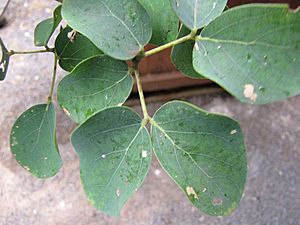Ka palupalu o Kanaloa facts for kids
Quick facts for kids Ka palupalu o Kanaloa |
|
|---|---|
 |
|
| Conservation status | |
| Scientific classification | |
| Kingdom: | |
| (unranked): | |
| (unranked): | |
| (unranked): | |
| Order: | |
| Family: | |
| Subfamily: | |
| (unranked): | |
| Genus: |
Kanaloa
Lorence & K.R.Wood
|
| Species: |
K. kahoolawensis
|
| Binomial name | |
| Kanaloa kahoolawensis Lorence & K.R.Wood
|
|
Kanaloa kahoolawensis, also known as Ka palupalu o Kanaloa or kohe malama malama o kanaloa, is a very rare flowering plant. It belongs to the legume family, called Fabaceae. This plant is found only in Hawaii, which means it is endemic to the islands. Kanaloa is a special group of plants with only one known species: K. kahoolawensis.
Contents
History of the Kanaloa Plant
Discovery of Kanaloa kahoolawensis
The Kanaloa plant was first found in 1992. Two botanists, Ken Wood and Steve Perlman, from the National Tropical Botanical Garden, discovered it. They found this rare plant on Kahoʻolawe, a small Hawaiian island.
Kahoʻolawe Island's Past
Kahoʻolawe has a long history. From 1826 to 1853, it was a prison island for the Hawaiian monarchy. Later, it was used for ranching. Sadly, the island's plants were badly damaged by dry weather and the animals grazing there.
Naming the Kanaloa Plant
When the plant was found, only two wild ones were growing on the island. In 1994, Lorence and Wood officially named the plant. The genus name, Kanaloa, honors a Hawaiian god. According to legends, the god Kanaloa used the island to rest and regain his strength.
Scholars and native Hawaiian activists believe "Kanaloa" comes from "Kohemalamalama O Kanaloa." This means "the place or womb for the resuscitation of Kanaloa." The name Kanaloa also means "secure, firm, immovable, established, unconquerable." These words describe how tough this plant must be to survive on the damaged island. The second part of the name, kahoolawensis, simply comes from the island Kahoʻolawe, where it was first found.
Where Kanaloa Lives
Current Home of the Plant
Today, only one wild Kanaloa kahoolawensis plant is known to exist. It grows on the cliffs of Aleʻale Puʻuloae. This spot is on a sea stack, which is a tall rock column, just off the coast of Kahoʻolawe. It grows at an elevation of about 45–60 meters (148–197 feet) above sea level. The soil there is made from volcanic rock.
Past Locations of Kanaloa
Scientists think that this plant might have grown on other Hawaiian islands in the past. They found old pollen that looks like it came from Kanaloa plants. This pollen was found in core samples from sinkholes on Oʻahu, Maui, and Kauaʻi.
It's hard to know for sure if this fossilized pollen is from K. kahoolawensis itself. However, Kahoʻolawe was once connected to Maui and other islands a very long time ago. So, it's possible the pollen is from the same species. It could also be from a different, now extinct, type of Kanaloa plant that lived on Oʻahu.
What Kanaloa Looks Like
K. kahoolawensis is a small shrub that grows to about 0.75–1 meter (2.5–3.3 feet) tall. Its branches are thick and spread out, measuring 0.75–1.5 meters (2.5–4.9 feet) long. New parts of the plant are covered in tiny, soft brown hairs.
Its leaves are special. They are made up of one pair of smaller leaf sections, and each section has three leaflets. These leaflets are oval-shaped and measure about 2.7–4.2 cm (1.1–1.7 inches) long and 1.4–3.2 cm (0.6–1.3 inches) wide.
The plant's flowers are white and grow in round clusters, like small balls, about 7.0–8.5 mm (0.28–0.33 inches) across. Each cluster can have 20 to 54 flowers. The flowers are mostly male, meaning they produce pollen.
After flowering, the plant produces fruits. These fruits are flat and round or oval-shaped, about 2.4–3.2 cm (0.9–1.3 inches) long and 2–2.3 cm (0.8–0.9 inches) wide. Each fruit usually holds just one seed.
Plant Family Tree: How Kanaloa is Related to Other Plants
|
|||||||||||||||||||||
| Phylogenetic tree of Leucaena group |
Scientists study the DNA of plants to understand how they are related. Based on these studies, Kanaloa is closely related to two other plant groups: Schleinitzia and Desmanthus.
These plants share some features. For example, they don't have thorns or prickles. Their flowers grow in round clusters. However, Kanaloa has some differences. For instance, its fruits open along their edges to release seeds. Kanaloa is most similar to Desmanthus, sharing features like special flower parts and how their fruits open. But Kanaloa has three leaflets per leaf section and heart-shaped seeds, which are different from Desmanthus.
Protecting Kanaloa
Conservation Efforts
Because Kanaloa kahoolawensis is so rare, a lot of effort goes into protecting it. Besides looking after the wild plants, people are working to grow more plants in nurseries and gardens. The goal is to have at least 25 individual plants growing safely.
Protecting Wild Plants
Fences have been built around the single wild plant on Kahoʻolawe. This helps protect it from animals like goats that were brought to the island and could eat or trample the plant. Experts regularly check the plants for any signs of insect damage or disease.
Growing New Plants
One plant grown from a seed is now kept at the National Tropical Botanical Garden’s McBryde Garden on Kauaʻi, Hawaii. This helps ensure the species survives, even if something happens to the wild plant.


